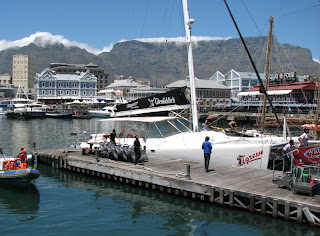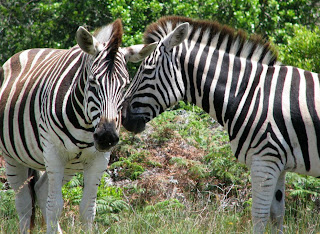I'm moving on "unknown territory" today because I'm no expert on reptiles; yet I have some photos I'd like to share of what I used to simply classify as geckos but learned in the mean time are Agamas.


Did you know that there are NO poisonous lizards in southern Africa? (In contrast to 2 species of poisonous lizards in North & South America).
The rock agama's diet consists mainly of ants and termites. Rock agama are well-known because their range is extensive. Although agamas (= lizards) aren't poisonous, a rock agama can inflict a painful bite, which draws blood - it has 2 fang-like teeth in its upper jaw. Also similar to the chameleon is the rock agama's ability to change its body colour.
In South Africa ALL reptiles are protected by law and without a permit it's illegal to keep any specimen in captivity.

This rock agama (left) also "originates" from Table Mountain.
And now for "comparison's sake" - a tree agama (right). Tree agamas are large and the head only turns blue when the agama is fully grown. A tree agama lays its eggs in a hole in the ground (= most female reptiles are egg-laying).
The diet of a tree agama (left = a close-up photo of the same agama above) consists of caterpillars, grasshoppers + beetles (= flying insects).
Last but not least - a ground agama (left). Like the other agama species, it has a broad, toad-like head and a long, thin tail. The ground agama is "bulky and less spritely" and its armoury of scales is very spiny.
Saturday, January 31, 2009
Agama Confusion
Thursday, January 22, 2009
The Moody Mountain
My photo "subject today is Table Mountain - known to the Khoi-Khoi (or the Quae-Quae, as I prefer what the original Dutch settlers at the Cape called "Hottentot") as Hoerikwaggo, the Sea Mountain.
The view (above) of Table Mountain with Devil's Peak in front and Lion's Head to the right is from a north-westerly direction, where my brother and his family live in Plattekloof.

Mountain is visible from 200km out at sea. On the other hand and from the summit, a visitor has spectacular views all around or a birds-eye-view of the city. The most common vegetation on Table Mt is fynbos (= Cape Floral Kingdom = richest floristic region in the world!) and over 1500 species of plants occur on the mountain alone! Amongst a great variety of fauna (mainly invertebrates) visitors will encounter the Dassie (= rock hyrax).






I'm aware that various variations exist to this story/legend/myth, but I presented "my version" to you.
Can you see Van Hunk and the Devil smoking?
Friday, January 16, 2009
Colourful Plumage
Time to go birding again! Since I haven't "dedicated" a posting to birds (my favourite subject) lately, I certainly think it's time to do that again.
I think of a Carmine bee-eater (right) as coming in many guises - every time I have the opportunity to photograph one, it looks different - mostly it's a matter of lighting (from which angle the sun shines) but everyone still has its own "character". Bee-eaters in general are highly coloured and aerial acrobats.
Why do goshawks and the like often have to perch on overhead cables? Since our son-in-law mentioned it I also prefer to snap birds on branches or dry stumps. This Dark Chanting goshawk (left) was too fine a specimen though (and "posing" so nicely) for me not to click away. Goshawks are known as ferocious raptors and chanting goshawks owe their name to their melodious call - rather a surprising performance for a bird of prey?
Did you know that goshawks (= goose-hawks) were once used for hunting wild geese and other fowl?
Ugly yet interesting - that's how I tend to classify the Marabou stork. Although it's a member of the stork family, it has a lot in common with vultures, e.g. it's predominantly a scavenger and also soars high on thermal currents - with grace! The skin-pouch under the marabou's bill is inflatable.
When I saw this Longtoed plover recently during a trip at the Chobe River (Botswana), I was very excited because I "met" it for the very first time. According to our bird books it's an uncommon localised resident - so I understand now why I haven't seen it (in the same environment) before. The word 'plover' rhymes with 'lover' (not 'rover') and is said to be derived from the French word pluvier (= 'to rain') - possibly because plovers tend to be restless especially before rain?
Cute - that's the first word I think of when looking at a Blue waxbill (right) with its combination of pastel and bright blue plumage. The one in my photo must be a male because the females are overall much paler than the males.
And this is (photo right) what the Plumcoloured starling looks like from the front - photograph "by courtesy" (= "stolen") from our son-in-laws photo collection.
Tuesday, January 13, 2009
Zebra Crossing
Zebra's are native to central and southern Africa.
I've known for quite a while that there are 3 species of zebra, but until I did a bit of research for today's entry, I always thought that 3 species are: 1) Burchell's 2) Cape Mountain & 3) Hartmann's zebra. Well, now I know that the Burchell's zebra is one of 5 Plains zebra (the other: Grant's, Chapman's, Selous' & Quagga) and that the Cape Mountain & Hartmann's zebra are 2 (related) subspecies of the Mountain zebra.
The 3rd and to me (so far) "unknown" species is the Grevy's zebra, said to be the largest type with an erect mane and a narrow (mule-like) head. It is found in Ethiopia, Somalia & Kenya (Note to self: time to visit at least one of these countries!?).
All zebra have vividly black and white VERTICAL stripes (mainly on forequarters) after which THE zebra crossing is named!
Distinctive on the Burchell's zebra are the "shadow" stripes (between the black ones) mainly on the hindquarters. Another example of a Burchell's zebra, snapped at the Seaview Game Park just outside Port Elizabeth. There's a notable difference between the zebras on the first 2 photos, yet if I'm not wrong (??) they belong to the same subspecies (= Burchell's zebra) of the Plains zebra species.
Another example of a Burchell's zebra, snapped at the Seaview Game Park just outside Port Elizabeth. There's a notable difference between the zebras on the first 2 photos, yet if I'm not wrong (??) they belong to the same subspecies (= Burchell's zebra) of the Plains zebra species.
Burchell's zebra are gregarious by nature and often associate with other animals, especially wildebeest. Note the short ears of the Burchell's zebra species!
The Mountain zebra is 1 of the world's rarest large mammals.
Did you know that some old male mountain zebra have the "distressing" habit of gelding young males?
By way of distinction from the other 2 species - it appears that "more" HORIZONTAL stripes feature on the Hartmann's zebra hindquarters. The Hartmann's zebra also looks more "white" than the Cape Mountain zebra.
On a similar note: once, a cabinet minister is supposed to have called zebras (in general) "donkeys in football jerseys". We, as tourist guides, often say teasingly: "donkey in pyjamas".
Burchell's zebra at a water-whole in Etosha - from the front........
- from the back..........
- and the same ones from the back after something scared them.
Friday, January 9, 2009
Festive Cheer
Wishing all my "visitors" happiness and success for the new year!
During the holiday season we spent some time with our daughter and son-in-law, who live and work in Port Elizabeth - and today's photos "stem" from that visit. Since all 4 of us enjoy birding and wildlife, we "couldn't resist" taking a "walk on the wild side".
Did you know that there are about 130 species of dragonflies in South Africa? [Not to be confused with the less robust and less active damselflies].
Did you know that the tusks of a warthog are actually upper canine teeth curled upwards?
In South African terminology, tortoises are land animals; turtles = sea-dwelling; and terrapins = fresh water species.
Did you know that all reptiles are creatures of a very ancient "lineage"? Their "ancestors" roamed earth (and seas) even before dinosaurs "held sway".
Can't this Cape bulbul read?
Did you know that 'bulbul' is an Arabic word? And that it was the "name" for a Persian nightingale?
In SA, bulbuls are less fabulous birds, but some of them do utter melodious and cheerful calls.
Our son-in-law suggested that we go on a night-game drive. Unfortunately (and probably because of windy conditions that night) we didn't encounter many night-active animals. But this pair of male lions certainly was a "treat".
King of the jungle? This generally greedy and lazy cat?
Do these 2 Burchell's zebra "share a secret"? It certainly looks as if the one is whispering into the other's ear!?
Zebra are unique to Africa but probably counts as one of the most photographed of wild animals.
Did you know that a zebra's stripes are as unique as a human's fingerprint?
I photographed this pair at BayWorld (Oceanarium) in PE. Previously known as the Jackass penguin (because of its donkey-like braying, which it exhibits on its breeding grounds), this is the only penguin species resident on the African continent.

















